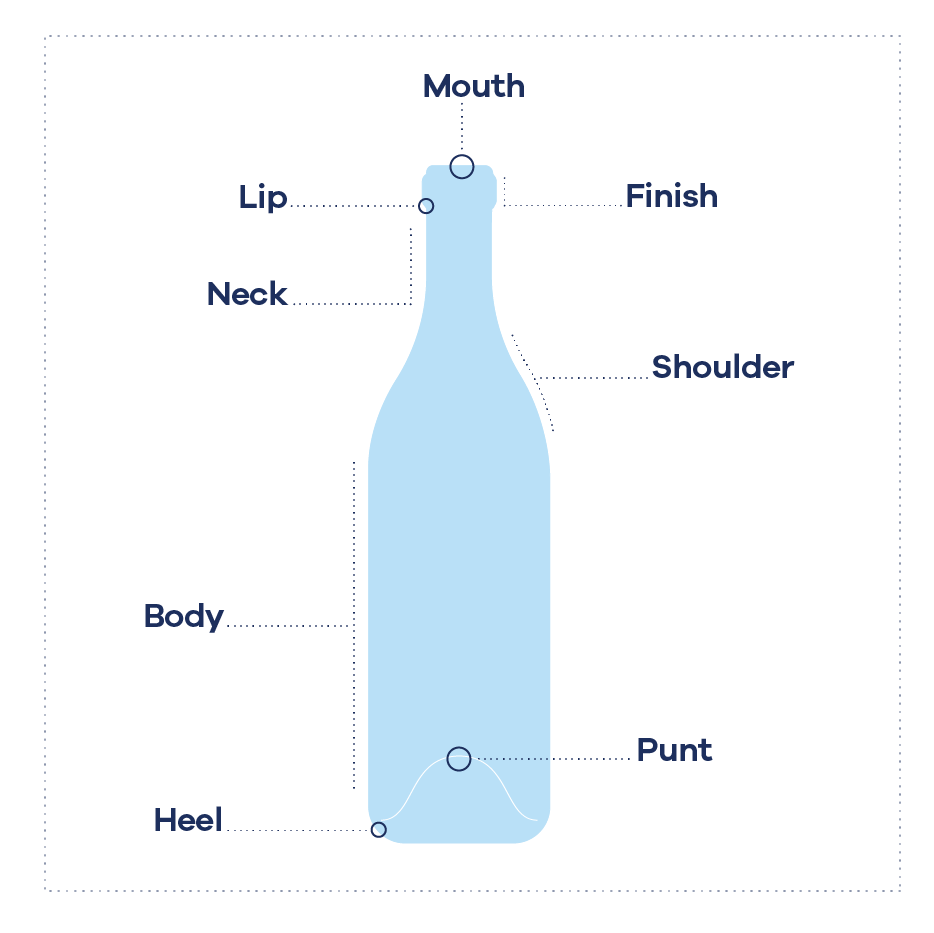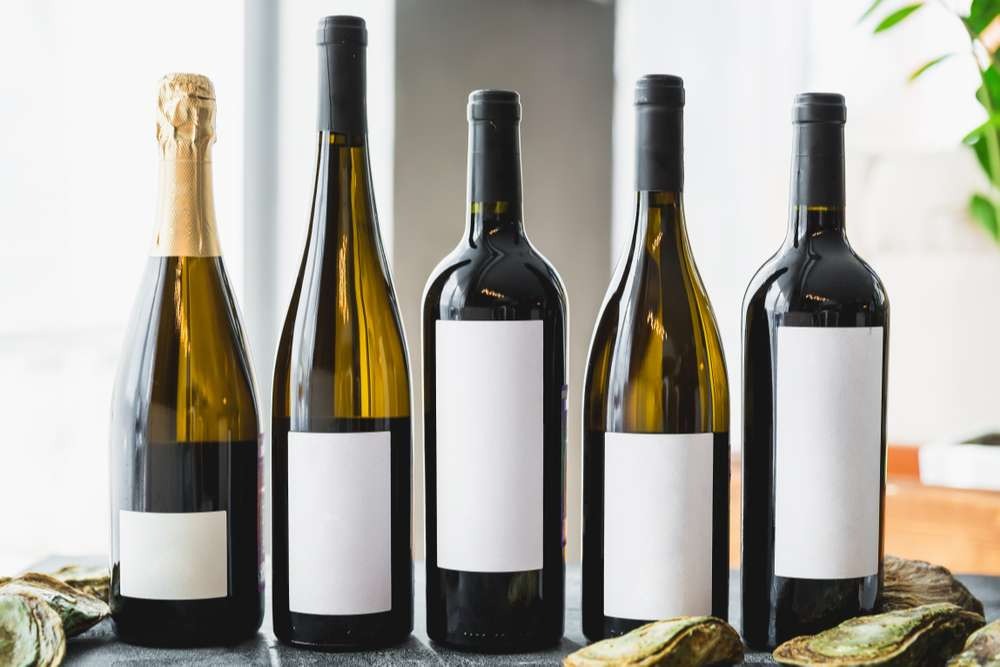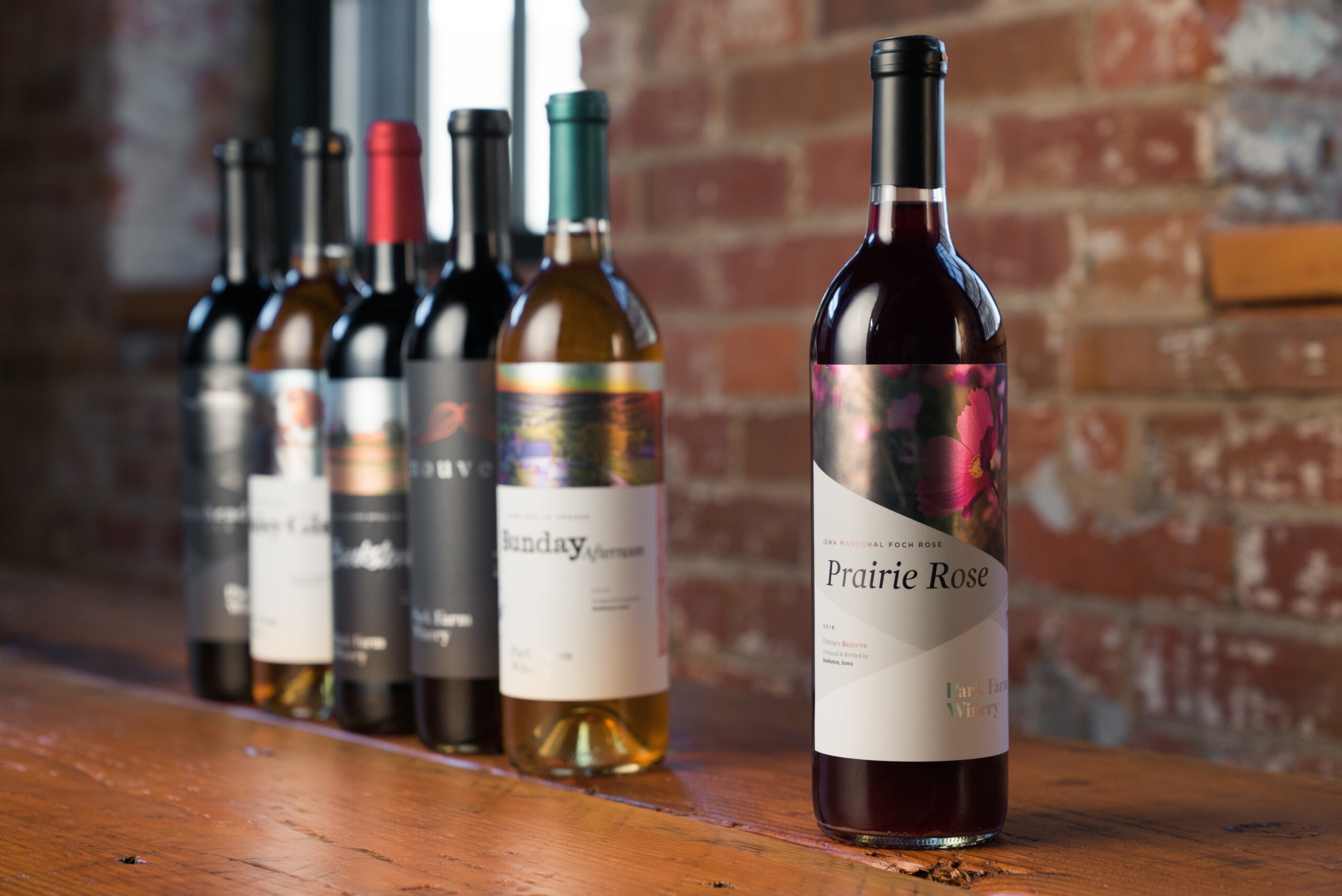A wine bottle may appear to be a straightforward object, but a closer look reveals a carefully considered design. Beyond simply containing the wine, each part of the bottle—from the seal at the top to the indentation at the bottom—plays a role in preservation, presentation, and even pouring. Understanding these components not only enhances your appreciation for the craftsmanship behind the wine but also clarifies the vocabulary used in the wine world. Let’s explore the anatomy of a wine bottle and the purpose of each of its key parts.

Table of Contents
Closures: Sealing the Bottle
The closure might just be the most crucial component of wine packaging. Its primary job is simple but vital: to seal the bottle and protect the wine inside, ensuring it reaches the glass as the winemaker intended. However, not all closures are created equal, and the choice significantly impacts the wine’s aging, style, and even our perception of it.
Here’s a look at the most common types of closures found in the market today.
Traditional Corks
For centuries, natural cork has been the classic choice. Harvested from the bark of cork oak trees, it’s a renewable resource that allows a tiny, controlled amount of oxygen to interact with the wine, which can benefit certain wines during extended aging. The main drawback is a small risk (around 1-3%) of cork taint, known as TCA, which can give the wine a musty odour.
As a more affordable alternative, Agglomerated Corks are made from compressed cork particles. They are a practical and cost-effective option for wines meant to be enjoyed within a few years of bottling.
Modern Alternatives
In response to the demand for consistency and innovation, several modern closures have emerged:
Screw Caps: Extremely popular in countries like New Zealand and Australia, screw caps (often under the brand name Stelvin) provide a precise, airtight seal. They eliminate the risk of cork taint and are perfect for preserving the fresh, fruity character of wines meant to be consumed young.
Synthetic Corks: Made from food-grade plastic, these closures also remove the risk of TCA. While they offer a consistent seal, they can sometimes allow more oxygen transfer than ideal, which may affect the wine’s long-term aging potential.
Glass Stoppers (e.g., Vinolok): Offering a touch of modern elegance, glass stoppers create an almost impermeable seal with the help of a small O-ring. They are reusable, 100% recyclable, and free from TCA, but their higher cost often reserves them for premium wines.
Why the Closure Matters
A winery’s choice of closure is a significant decision influenced by cost, wine style, target market, and sustainability goals. Each type manages the flow of oxygen differently, directly impacting how—and how long—a wine can age. It also affects the practicalities of storage, opening, and even the consumer’s first impression of the bottle.
From an environmental perspective, natural cork is often highlighted for its sustainability, as cork forests are a valuable ecosystem. Meanwhile, the recyclability of aluminum screw caps and synthetic corks continues to improve as manufacturers focus on their environmental footprint.
The Capsule: More Than Just a Cover
Before you open a bottle of wine, you first encounter the capsule—that sleek sleeve of metal, plastic, or wax covering the cork and neck. While it might seem like a simple decorative wrap, this small component plays several important roles in both protecting the wine and completing its presentation.
Primarily, the capsule acts as a guardian. It forms a protective barrier that helps prevent the cork from drying out, minimizes evaporation, and keeps dust and pests away from the closure. From a practical standpoint, it also ensures the top of the bottle remains clean for serving. Beyond function, the capsule is a key part of the bottle’s identity, giving it a polished, finished look that reinforces the winery’s branding.
In many European regions, the capsule also serves an official purpose. It often bears specific stamps, color codes, or serial numbers that act as a seal of authenticity, particularly for Appellation d’Origine Contrôlée (AOC) wines in France.
A Look at Common Capsule Materials
Winemakers choose from a range of materials, each with its own characteristics:
Tin: Considered the premium choice, tin is soft and malleable, giving a luxurious, high-end feel. It is commonly found on prestigious wines, such as Bordeaux Grands Crus, though it comes at a higher cost.
Aluminum & Polylaminate: A cost-effective and flexible option, aluminum is widely used for everyday wines. A more durable version, polylaminate, combines layers of aluminum and plastic, offering extra strength for wines that are shipped long distances.
Wax: Evoking a sense of tradition and craftsmanship, wax seals are often used for artisanal or boutique wines. Applied by hand, they create a unique, rustic appearance but are less common in large-scale production.
PVC/Plastic: This is the most budget-friendly option, typically used for high-volume, entry-level wines.
Material | Cost & Use | Key Features | Typical Examples |
|---|---|---|---|
Tin | High; luxury | Premium look, malleable | Bordeaux Grand Cru |
Aluminum | Low; common | Flexible, efficient | Export and everyday wines |
Polylaminate | Moderate; export | Durable, dent-resistant | Export brands |
PVC/Plastic | Lowest; mass | Cheap, practical | Entry-level, high-volume wines |
Wax | Varies; artisanal | Traditional, hand-done | Old World and boutique bottles |
While capsules are a small detail, they are a fascinating intersection of function, law, and marketing. The choice of material not only affects the bottle’s appearance and cost but also contributes to the overall story and perceived value of the wine inside.

The Neck: Where Form Meets Function
The neck of a wine bottle is the crucial bridge between the main body and the opening. While it may seem like a simple tube, its design is precisely engineered to securely hold the closure and ensure a smooth pour.
A bottle’s neck is tailored to its intended closure, leading to variations in its shape and dimensions. The two primary designs are:
Cork-finished Necks: For a natural cork to work effectively, the internal diameter of the neck must be precisely controlled. If the glass widens too much just below the opening, it can compromise the seal, leading to potential leakage or premature oxidation.
Screw-cap Necks (BVS): Bottles designed for screw caps feature a threaded finish with specific dimensions to ensure the cap twists on smoothly and locks securely. This design includes a small locking bead and a precise taper, which work together to create a consistent, leak-resistant seal that is ideal for automated bottling lines.
These subtle differences in design are why the neck of a sturdy Bordeaux bottle might feel different from a broader, “fatter” Burgundy bottle. Each is optimized for its specific role—whether it’s to cradle a cork for long-term aging or to perfectly seat a modern screw cap for preserving freshness.
Ultimately, the neck is a masterpiece of functional design. Its unseen precision is what keeps the seal intact, protects the wine inside, and gives you the confidence that the bottle will open and pour just as it should.
The Shoulder: A Blend of Form and Function
The shoulder of a wine bottle—the sloping curve connecting its main body to the neck—is far more than an aesthetic choice. Its shape plays a practical role in both the wine’s journey and the consumer’s experience, helping to manage sediment and define a bottle’s character.
The most classic example of form following function is the Bordeaux bottle. With its high, sharply angled shoulders, this design is purpose-built for wines that benefit from aging and may develop sediment. When pouring, these pronounced shoulders help trap the sediment in the bottle, ensuring a clearer wine in the glass.
In contrast, the Burgundy bottle features a gentler, more sloping shoulder. This elegant design offers a distinct visual identity for varieties like Pinot Noir and Chardonnay but is less effective at controlling sediment during pouring.
Other styles, like the Rhône bottle, offer a middle ground with a moderately sloped shoulder, blending elements from both major styles.
Beyond its role in serving, the shoulder influences the bottle’s overall stability and how it fits into wine racks. It also defines the space available for the label, directly impacting the bottle’s shelf presence and brand recognition. In many ways, the shoulder serves as a quick visual cue, often allowing you to identify the wine style and its typical contents before even reading the label.

The Body: The Bottle’s Central Canvas
The body is the main section of the wine bottle, housing the majority of the wine. Its shape and proportions are not arbitrary; they are deeply connected to the wine’s identity, affecting everything from storage and presentation to the drinker’s unconscious perception.
Primarily, the body serves as the canvas for the label, providing the largest and most visible space for branding and essential information. Its dimensions are also crucial for stability, ensuring the bottle stands securely on a shelf or table.
More subtly, the body’s shape often serves as a visual clue to the wine’s style. The straight, cylindrical silhouette of a Bordeaux bottle is instantly recognizable, while the wider, curvier form of a Burgundy bottle suggests a different tradition inside. Slender, elegant bodies are typically reserved for aromatic white wines from regions like Alsace and Mosel.
Beyond aesthetics, the body’s design has practical implications. A wider body can influence how aromas develop and how sediment settles over time. While most bottles maintain a standard cylindrical form for efficient packing and stacking, some special editions may feature unique, non-standard shapes to stand out and make a statement.
In essence, the body of a wine bottle masterfully balances practical needs with visual storytelling, shaping our initial impression long before the cork is pulled or the cap is twisted.
The Heel: The Foundation of Stability
The heel, often overlooked, is the very bottom rim of the wine bottle that makes contact with the surface beneath it. This simple ring of glass serves the essential purpose of providing a stable foundation, ensuring the bottle stands upright and remains balanced.
Working in tandem with the punt—the inward dimple at the base—the heel adds significant structural strength to the bottle. This robust foundation helps distribute pressure evenly, a feature particularly important for sparkling wines, and adds overall durability to prevent breakage.
While its primary role is functional, the heel’s profile can vary subtly between classic bottle shapes, like the distinct styles of Bordeaux and Burgundy bottles. Furthermore, its design becomes critically important in larger format bottles, such as Magnums and beyond, where it must be substantial enough to support the increased weight of the wine inside.
Feature | Description/Importance |
|---|---|
Location | Bottom-most part; touches the surface |
Function | Keeps bottle upright and stable; foundation for bottle |
Shape Variation | Adapts to Bordeaux, Burgundy, Rhone bottles and other shapes |
Relation to Punt | Adds strength, pouring grip, and stability; works with central punt |
Material | Glass, often extra thick in premium bottles |
Relevant Bottle Sizes | Critical for standard 750 mL, but even more for large bottles up to 15 L (Nebuchadnezzar) |
In essence, the heel is a masterclass in simple, effective design. It is the unsung hero that provides the steady base for every bottle, from the everyday table wine to the most prestigious vintage.
The Punt: More Than Just a Dimple
That deep indentation at the bottom of a wine bottle, known as the punt, is a feature steeped in history and function. While a common misconception is that a deeper punt signifies better wine, this is not true—a 750ml bottle always contains the same volume, regardless of the punt’s depth.
So, what is its purpose? Historically, the punt served a practical role in glassblowing, helping to reinforce the bottle’s base and improve its stability on a flat surface. For still wines, especially those intended for aging, the punt helps consolidate sediment into a ring, making it less likely to be poured into the glass.
Its functional role is most critical in sparkling wines. The punt strengthens the bottle base to better withstand the high internal pressure from carbonation, enhancing safety. It also aids in handling; during the traditional méthode champenoise, riddlers grip the punt to slowly twist the bottle, and sommeliers often place their thumb in the dimple for a secure, elegant pour.
Beyond practicality, the punt plays a marketing role. A deeper indent can make a bottle feel heavier and more substantial, subtly suggesting a premium product. While its technical necessity in modern winemaking may be debated, the punt remains a distinctive element of a wine bottle’s character, blending tradition, function, and perception.
The Base: The Bottle’s Foundation
The base of a wine bottle is its literal foundation, providing the essential stability that keeps it standing upright. Its design is a thoughtful blend of engineering and practicality, centered around a raised, ring-shaped surface—often with a subtly textured finish—that makes direct contact with the table.
This robust foundation is built to bear weight. The glass is notably thicker here, especially in sparkling wine bottles where the base must be reinforced to withstand the high internal pressure from carbonation. This makes the bottom one of the strongest parts of the entire bottle.
Beyond simple stability, the base serves several discreet purposes. The textured ring helps to minimize visible scratching during transport and handling. It also typically features molded-in identification numbers and recycling symbols used in the manufacturing process. Some bases even include a small recess or projection that helps automated machinery position labels with precision during bottling.
While often discussed in tandem with the punt (or “push-up”), the base’s primary role is foundational. It is the unsung hero that ensures every bottle, from a casual table wine to a vintage Champagne, stands firm and secure.

Conclusion: The Harmony of Form and Function
From the closure that seals in freshness, to the capsule that provides protection, and down through the neck, shoulder, body, and foundational base, every component of a wine bottle plays a vital role. As we’ve seen, this is not just a simple glass container but a masterpiece of functional design, where engineering, tradition, and branding converge to deliver the perfect wine experience.
At TP Glass Bottle Manufacturer, we understand this intricate harmony intimately. We don’t just produce glass bottles; we craft the very vessel that defines a wine’s first impression and ensures its preservation. With a deep expertise in the nuances of material selection, structural integrity, and custom design, we partner with wineries to create packaging that truly reflects the quality and character of the wine within.
Whether you require the classic elegance of a Bordeaux bottle, the robust base for a sparkling wine, or a fully custom design to make your brand stand out, we have the precision and passion to bring your vision to life. Let’s build the perfect bottle for your story, together.

